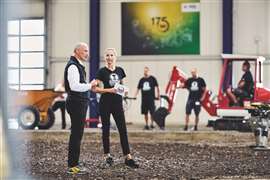Interview: Wacker Neuson Chief Sales Officer on growth for the future
December 11, 2023
Construction equipment manufacturer Wacker Neuson has been at the forefront of many of the industry’s innovations. This year, the OEM celebrated its 175th anniversary and invited customers and dealers to its site in Reichertshofen, Germany.
During the celebrations, Alexander Greschner, Chief Sales Officer at the Wacker Neuson Group, took some time to talk to International Construction about the future of construction and the plans the company has in place to meet these needs.
 Alexander Greschner, Chief Sales Officer, Wacker Neuson (Photo: Wacker Neuson)
Alexander Greschner, Chief Sales Officer, Wacker Neuson (Photo: Wacker Neuson)
When asked about the regions the company will focus on for growth, Greschner revealed that they are taking a global approach but that there is still potential for growth in Europe and North America.
“Our home base is in Central Europe, and we strive to continuously develop our market shares, but we can’t expect to make leaps from 30% to 40% or 50%. Despite this, there is still a lot of room for growth in Europe,” he said.
“Asia Pacific is a highly important region but keeping the position and expanding the position in Europe and North America, that’s the focus.”
Last year, Wacker Neuson and John Deere announced that they are collaborating to develop excavators weighing less than five metric tons. Greschner revealed that this is a key component for the company’s growth plans in North America.
For Greschner, battery electric was the “right way to go at the right time”. He says that the company did the groundwork before any legislation came in, which gave them a head start on many of their competitors.
Over recent years, governments across the world have incentivised the switch to electric and made it part of the requirements to win specific contracts and tenders.
“I think leading the way are Norway and the Netherlands; they are extremely demanding and are driven by legislation.
“More than five German cities and major capital cities across Europe are all joining. There are different demands and subsidising efforts from governments in Europe,” he says.
Despite the push through government initiatives, he says it still has to be the correct business decision. “That means it has to be an economical and sustainable solution for our customers, for us, but also for the builders, the owners and the people that finance projects.”

Building an ecosystem
Electrification of construction equipment is one of the industry’s biggest trends and partnerships and collaboration are key. Electric equipment charging infrastructure and battery technology are significant components of this journey that cannot be solved by one company.
“It’s too big for us to solve on our own,” says Greschner. “It’s an extremely important thing for us as a manufacturer to be very open-minded, but also very open on the interfaces that our machines have.
“I would say the biggest initiative we have done in the last three years was Battery One, today used across all major players in the light equipment sector [including Mikasa, Swepac and Enar]. Independent of brand, independent of product model and generation, the same battery can be used by our customers for a variety of rammers, plates and concrete consolidation backpack solutions.”
This means users do not have to worry about different charger or batteries. Greschner says that similar developments will be seen in the area of compact machines.
“If we have a group of manufacturers working together on the same standard, it’s obviously creating progress much faster than if all the individual players are working by themselves with their limited resources on compact machines,” he says.
“It’s about increasing the charging standard, and there are now manufacturers that are opening up. Between the manufacturers, there is an opening up for these data interfaces, as well as to take some headache away from customers that have to look at too many solutions.”
Greschner is positive that there will be clarity in both the European and North American markets by the middle of next year. “We are convinced that we will be able to push a standard in the next six to nine months.”
Besides electrification, Greschner says that operator assistance and safety remain as important as ever as.
 Wacker Neuson was an early adopter of electric powered equipment (Photo: Wacker Neuson)
Wacker Neuson was an early adopter of electric powered equipment (Photo: Wacker Neuson)
“As we have more and more products going into the rental industry, you have operators changing products every day,” he says. “You have to make sure that the operation is safe and simple. Even behind complicated products and applications, it needs to be simple.”
Focusing on efficiency
A major step could also lie in the complete electrification of powertrains, says Greschner.
He says that the powertrain will start with the replacement of the combustion engine by battery and electric motor. But the biggest potential of efficiency starts in the remaining powertrain, where hydraulic and mechanic components are consuming a lot of energy.
“We have some samples on our small products where we did electrify the complete powertrain and doubled the efficiency, working with half the resource of battery to run a machine. This direction will be the game changer in the future.”
STAY CONNECTED



Receive the information you need when you need it through our world-leading magazines, newsletters and daily briefings.
CONNECT WITH THE TEAM








